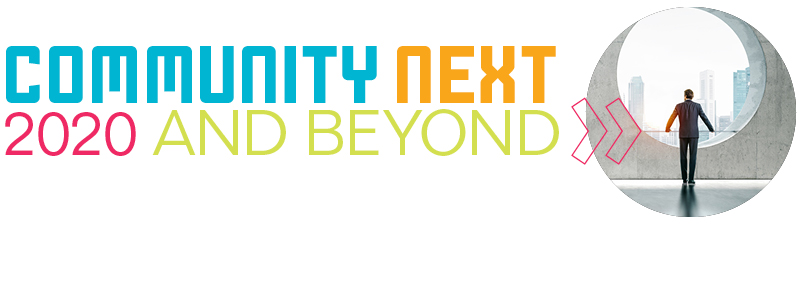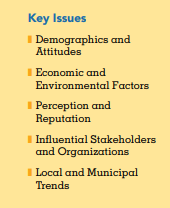
External Influences
 Today, an estimated 67 million Americans—
about 20.7 percent of the population—live
in 333,600 homeowners associations,
condominiums and cooperatives. In the
coming decades, these figures are expected to grow,
giving associations and their leaders increasing
influence and attention.
Today, an estimated 67 million Americans—
about 20.7 percent of the population—live
in 333,600 homeowners associations,
condominiums and cooperatives. In the
coming decades, these figures are expected to grow,
giving associations and their leaders increasing
influence and attention.
At the same time, community association volunteer
board members, professional managers and
community business partners will face a number
of challenges and factors—largely beyond their
control and expertise—that will affect commoninterest
communities. The External Influences
Panel discussed some of these influences and what
can be done to mitigate the negative and accentuate
the positive.
 The panel predicts that changes in demographics
and attitudes, economic factors, perception and
reputation, influential stakeholders and organizations,
local trends and more will combine to affect
how associations are operated and governed in the
next 15 years. These elements largely are interrelated.
For associations to continue to thrive as the
preferred places to call home, CAI and association
leaders may need to adapt and prepare their communities
for the evolution of community association
living.
»PREPARE FOR MULTIPLE
GENERATIONS AND INCREASING
DIVERSITY
From millennials and Generations Y and X to
baby boomers and the matures, common-interest
communities increasingly will serve multiple generations.
Associations will need to revise their
communications strategies, operations, assessment
collections, reserves for deferred maintenance, governance
and meeting schedules to accommodate
the broadened audience.
The panel predicts that changes in demographics
and attitudes, economic factors, perception and
reputation, influential stakeholders and organizations,
local trends and more will combine to affect
how associations are operated and governed in the
next 15 years. These elements largely are interrelated.
For associations to continue to thrive as the
preferred places to call home, CAI and association
leaders may need to adapt and prepare their communities
for the evolution of community association
living.
»PREPARE FOR MULTIPLE
GENERATIONS AND INCREASING
DIVERSITY
From millennials and Generations Y and X to
baby boomers and the matures, common-interest
communities increasingly will serve multiple generations.
Associations will need to revise their
communications strategies, operations, assessment
collections, reserves for deferred maintenance, governance
and meeting schedules to accommodate
the broadened audience.
 In general, residents will be more interested in
walkability, amenities and activities beyond golf
and tennis, and telecommuting. They’re placing a
higher value on open space too. There’s likely to
be more interest in association-provided maintenance
services, such as landscaping, snow removal
and other projects traditionally administered by
homeowners. Separately, each generation will present
different challenges to board members, managers
and association business partners. Baby boomers,
for example, will be coming to grips with the
savings lost during the Great Recession. With the
decline in pensions, and 401k and retirement plans
hit hard during the recent recession, there will be a
greater wealth disparity within retirees.
In general, residents will be more interested in
walkability, amenities and activities beyond golf
and tennis, and telecommuting. They’re placing a
higher value on open space too. There’s likely to
be more interest in association-provided maintenance
services, such as landscaping, snow removal
and other projects traditionally administered by
homeowners. Separately, each generation will present
different challenges to board members, managers
and association business partners. Baby boomers,
for example, will be coming to grips with the
savings lost during the Great Recession. With the
decline in pensions, and 401k and retirement plans
hit hard during the recent recession, there will be a
greater wealth disparity within retirees.
 Active boomers will seek more diverse amenities
and events that go beyond the typical golf,
gates and tennis ethos of today’s retirement communities.
Some associations will find themselves
evolving into pseudo-assisted living facilities, even
though they’re not prepared for the additional burdens
of aging residents. Some older residents may
require round-the-clock, live-in caregivers—contracted
healthcare providers and family members.
This may create conflicts with occupancy requirements,
parking restrictions and the like.
Active boomers will seek more diverse amenities
and events that go beyond the typical golf,
gates and tennis ethos of today’s retirement communities.
Some associations will find themselves
evolving into pseudo-assisted living facilities, even
though they’re not prepared for the additional burdens
of aging residents. Some older residents may
require round-the-clock, live-in caregivers—contracted
healthcare providers and family members.
This may create conflicts with occupancy requirements,
parking restrictions and the like.
Group homes, for example, typically run afoul
of governing documents in community associations.
Association CC&Rs may contain restrictions
that preclude providing additional services
to certain members such as the elderly, but aging
residents will expect their communities to make it
possible for them to remain in their homes. Future
associations may need to depend more on outside
services to meet the needs of older residents while
looking at physical modifications to the property
to accommodate diminished physical capacity.
Meanwhile, millennials and those in the iGeneration, who
are saddled with student loan debt, facing a difficult job market
and possibly unable to qualify for a mortgage, won’t be as eager
to buy a home as previous generations. They will be renting for
longer periods of time and will be more likely to move back
home and live with their parents after college. In addition,
they’re also expected to delay marriage and children and have
more interest in living in cities. For that reason, the development
of condominiums is expected to boom.
As for ethnic and cultural diversity, associations will become
less homogenous. Associations also may be counted on to provide
multilingual governing documents, rules, newsletters and
websites. Alternatively, translators may need to be on hand for
association meetings. To bridge the language gap, it also may be
beneficial for communities to embed photos and illustrations in
governing documents and publications.
»STAY ON TOP OF ECONOMIC AND
ENVIRONMENTAL ISSUES
Delinquencies and foreclosures caused by economic and environmental
factors during the Great Recession have battered
association operating and reserve funds. Today, most community
associations have recovered financially, and that trend is expected
to continue. However, association leaders will need to continue
to pay close attention to their accounts and pursue delinquent
owners when necessary.
In some states, association liens can take precedence over
mortgages, but courts may intervene and strip away those priority
liens. Meanwhile, the business world increasingly is moving
toward virtual offices and home-based employees, and—in the
age when small businesses can sprout up overnight with an idea
and a website—more residents will be working from home.
In addition to economic factors, association leaders will need
to receive even more education than they do today on environmental
and energy issues. Homeowners are expected to be more
interested in water conservation, xeriscaping, artificial turf, solar
panels, electric cars and charging stations. Board members and
managers in the South, Southwest and West, in particular, will
need to get up to speed on things like xeriscaping and recycled
water and may need to keep a constant eye on residents’ water
consumption. Municipal water providers and local and state governments
may count on association leaders to help them monitor
water use and abuse among residents and to lead the way through
water-wise common area landscaping and amenities.
These environmental issues, and possibly a new set in 15
years, could clash with association rules and regulations; they
also could impact where and how development occurs. The
availability of water is likely to have a significant influence over
where development occurs.
»ACCENTUATE THE POSTIVE ASPECTS OF
ASSOCIATIONS
CAI
chapters and association leaders still will be facing the
negative perception of common-interest communities from the
media in the next 15 years, and all stakeholders must do more to
accentuate the positive aspects. The challenge is exacerbated by
the budgetary crunch among traditional news outlets, which are
expected to turn more frequently to wire services and away from
original reporting. That will make sharing positive association
stories a greater challenge than it is today.
Association board members and managers need to be better
trained and educated on working with news outlets; they need to
learn how to frame things positively and proactively share their
stories. Efforts to change the perception of associations will be
critical in coming years. The negative reputation, especially in
media coverage, influences legislators and regulators, who then
work to create laws and standards to “fix” a problem that may
not exist.
In general, homebuyers don’t understand what an association
does or why it exists in the first place. Efforts must be taken to
explain the roles and responsibilities of associations. First-time
community association homeowners sometimes confuse who’s
in charge of development, transition and architectural review, or
why associations have rules and regulations. However, as more
people live in associations and have positive experiences, the
overall perception of associations will improve.
»CONNECT AND COLLABORATE WITH
STAKEHOLDERS AND ORGANIZATIONS
Association leaders also will need to work closely with influential
stakeholders and organizations, such as developers, real estate
agents and mortgage lenders. The NAHB, NAR and ABA exert
an incredible amount of influence over development, sales and
mortgage lending for homes in community associations. AARP, with its large, active membership
and powerful voice, also
impacts the success of
associations. Engaging
with these organizations
is crucial to
ensure commoninterest
communities
continue to be
considered preferred
places to call home.
Another key
group to connect
and collaborate with
is developers and their
attorneys, who are working
to improve governing documents
before they’re filed. Initial
board members and managers need
to pay close attention to their association’s documents—and the
typical checklist—during the transition process. And managers
engaged by the developer during the development process
should be encouraged to use their knowledge of post-development
association operational needs to steer the developer and
its attorneys toward drafting and filing appropriate governing
documents.
The business of developing community associations has
become increasingly litigious. Tremendous benefits would be
gained from providing enticing educational opportunities to
developers to reinforce to both developers and associations
that their interests are not mutually exclusive. Savvy developers
already understand that the possibility of litigation is lessened
when the development team pays attention to detail, supervises
contractors and sub-contractors properly, fully discloses to prospective
purchasers details of the project and makes a reasonable
contribution to reserves during the period of developer control.
The goal in this regard should be to help educate all developers
regarding these issues and thus greatly improve the quality of
new communities coming online.
Real estate agents must understand the nuances of community
associations. By partnering with NAR and offering
education to Realtors, who could then pass their knowledge on
to homebuyers, there likely would be fewer owners who don’t
understand the responsibilities and expectations of living in
associations.
»UNDERSTAND KEY TRENDS
A number of patterns in development and generational desires
will combine to impact associations too, but the extent of these
influences largely depends on geographical location. For example,
the Northeast Corridor and parts of Florida are running
out of large tracts of land for development, which is leading to
growth in townhome, condominium and small single-family
home communities—and a gentrification of existing structures
and property. That also may mean fewer amenities, lower assessments,
a compact governance structure and a focus on contracting
with service providers instead of hiring staff. As previously
stated, managers and board members will need to be better
versed in high-rise operations and governance with a special
focus on maintenance, necessitating more outreach to urban
high-rise managers.
The recent growth of rental properties and conversions of
condominiums into apartments is another key trend. Once these
renters gain enough equity and begin looking for ownership
opportunities, there may be a rash of conversions from rentals
into homeowners associations and condominiums—a cycle that
seems to repeat every 10 to 15 years. Meanwhile, as baby boomers
opt out of assisted living, they may turn to mother-in-law
suites within their children’s homes. Similarly, millennials may
be opting to move in to suites attached to their parents’ homes.
Associations may need to assess whether they’d accept these new
living situations and review and update their governing documents
accordingly. Managers and board members will need to be
knowledgeable in generational dynamics, communication styles
and more. Senior housing communities also may want to consider
strategic partnerships with healthcare facilities and hospitals,
which will benefit their aging residents.
FINAL THOUGHTS
While association stakeholders will need to prepare for these
coming challenges, seek education and advocate for communities,
the primary mission of associations will remain unchanged.
Volunteer board members, managers and business partners—
even CAI and its chapters—will be focused on maintaining and
improving property values and making communities preferred
places to call home. That means collecting assessments, enforcing
rules and restrictions, providing quality leadership and
more—no matter what external forces influence associations.